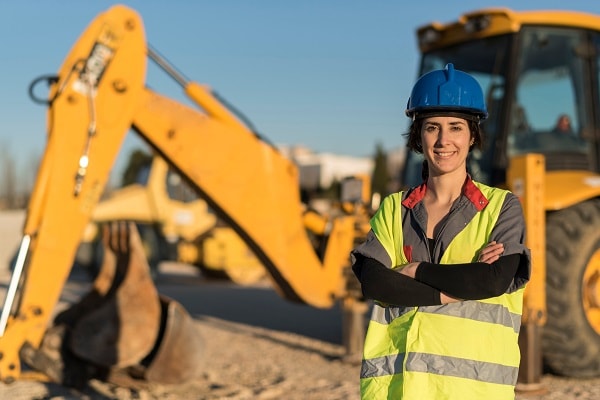Though traditionally few in number, the amount of women in construction has spiked dramatically over the past few years. While the industry remains largely dominated by men, exciting new prospects for women are in development.
From a mere 619,000 in 1985 to 1.1 million strong in 2007, you can now find women working across building sites with their male co-workers, supervising staff, leading projects and departments, and even running their own construction companies.
Today, the construction industry is brimming with opportunities for women with the right skills and capabilities. According to the Bureau of Labor Statistics (BLS), the construction industry will add about 400,000 new jobs from 2020-2030. With adequate training and skills, you can achieve major success by investing in the field.
In this article, we’ll take a closer look at the different ways women contribute to industry growth and the challenges they may face along the way.
Table of Contents
How Can Women Be Effective Contributors to the Growth of the Construction Industry?
-
Earn your degree in construction with NEIT. Apply today!
Loading…
/**/
The Boston Consulting Group surveyed diversity across 1,800 companies in eight countries. They discovered that organizations with above-average diversity had 19% greater innovation revenues. This relationship between innovation and diversity maintained a steady correlation in all locations.
As the industry looks for solutions to the growing workforce shortage problem, recruiting more women appears to be one of the most viable. Employing, educating, and supporting women construction workers is now deemed necessary to ensure long-term industry progress.
Though women represent an enormous potential workforce, they are significantly underrepresented in the construction industry. Across the board, women comprise just 7% of architects and engineers, 5% of contractors, and 4% of construction managers. While there is no single explanation for this disparity, many believe that institutional barriers keep women from progressing up the career ladder.
How Do Women Inspire Change?
Women bring about a much-needed balance in the workforce. Not only have women demonstrated the ability to effectively manage both career and family responsibilities, but they also add significant value to the workplace. According to a McKinsey and company report, gender-diverse companies are 25 percent more likely to achieve above-average profitability than companies with less diversity.
The report also highlights that when women filled 30 percent or more executive-level positions in a company, the companies were 48 percent more likely to outperform their least-diverse competitors.
START YOUR CONSTRUCTION CAREER
Earn your degree in Construction from NEIT and begin your new career path today!
ASSOCIATE'S DEGREE
BACHELOR'S DEGREE
MASTER'S DEGREE
The Present Status of Women in the Workforce

According to the BLS, women make up approximately 47 percent of the total workforce in the United States. The Institute for Women’s Policy Research (IWPR) report says that the number of women working in construction increased by 17.6 percent from 2017 to 2018, reaching well over a quarter of a million (276,000). The overall job growth stood at 3.7 percent in all construction occupations.
In 2018, the percentage of women in the construction industry stood at just 9.9 percent. In 2020, they constituted 10.9 percent of the entire workforce, signifying a steady increase in women’s employment within the past two years.
These figures highlight that the number of women in the construction industry is increasing year over year. Women are also now more open to multiple roles in the industry, ranging from trade jobs to construction management.
The Need for Women in Construction Management
According to a National Bureau of Economic Research paper, women are more likely to collaborate than men. This is important, as construction projects require a high level of collaboration. Hiring women increases the likelihood of teamwork and cooperation, leading to significant improvement in a company’s productivity and profits.
How Can Women Become a Part of the Construction Workforce?
The construction industry faces a worker shortage every year. Today, construction companies hire women in various roles and responsibilities ranging from trade jobs to heavy machinery operations and construction management. Forging a career in construction generally requires the following steps:

Earn a Secondary Education
Most construction jobs and degree programs require candidates to have their high-school diploma or GED. You can also improve your logical ability and skills in high school by opting for relevant subjects such as math, welding, woodshop, and technical drawing.
You can also kick off a career in construction by earning an Associate’s in Building Construction Technology. After completing your degree, you will qualify for employment in several fields, like civil and building engineering, commercial construction, residential construction, real estate, and facilities management.
You can also pursue a Bachelor’s Degree in Construction Management from the New England Institute of Technology. The curriculum consists of materials, design, economics, building sciences, and civil engineering, preparing graduates to transform project resources into finished constructions.
Obtain Relevant Qualification
If you intend to start your career as a construction worker, you can enroll in apprenticeship programs. These programs combine classroom learning with on-the-job training for two to four years and help you apply for entry-level jobs as construction workers.

Apply for Certifications
There are many certification options for aspiring candidates in the building industry. The Occupational Safety and Health Administration (OSHA) certification can provide you with the safety knowledge needed for new jobs.
Gain Practical Experience
Entry-level professionals can apply for internships and training programs to gain on-site experience. Working on construction projects also provides you with first-hand knowledge of construction site operations.

Pursue a Master’s Degree
Female leaders looking to advance their careers can pursue a Master’s Degree in Construction Management to qualify for leadership positions. These programs instruct construction and management subjects, including risk management, sustainability, finance, and dispute resolution, which can help you advance into management positions.
The online Master’s Degree in Construction Management at the New England Institute of Technology is an excellent option for working professionals seeking to advance their careers. We provide comprehensive degree programs in architecture, interior design, and construction management to help women kickstart a fulfilling career in construction.
Our robust curriculum focuses on a range of current and next-generation building technologies like automated construction methodologies, artificial intelligence, and advanced building materials. With a 10-week academic term, you can quickly master the skills and knowledge needed for a successful career in construction.
Learning Resources for Women in Construction

Women can rely on various learning resources to address their specific needs in the industry. These resources can also help potential employees prepare for the construction profession. They include:
Women’s Organizations
The National Association of Women in Construction (NAWIC), and the Women Construction Owners & Executives (WCOE), USA, are nationally recognized groups that provide networking, marketing, and mentorship opportunities. Engaging in such communities can give you the necessary support to establish yourself.
Construction Courses
Women interested in construction can take part in courses and boot-camp programs. If you’re a working professional, you can enroll in an online degree program to improve your job opportunities.
Specific training programs prepare women for certification exams and equip them with job-specific skills.
Construction Forums and Conferences
Construction forums such as NAWIC’s Annual Conference and the Groundbreaking Women in Construction conference include seminars, workshops, and training programs. Such meetings address women in construction and teach women more about adequate training, management roles, gender bias, and bridging pay gaps. NAWIC’s Women in Construction Week, held once every year, aims to highlight the importance of women in the construction industry.
You can follow online blogs, boot camp programs and participate in discussion forums to understand women’s roles and responsibilities in construction.
Challenges That a Woman in the Construction Industry May Face
Some of the challenges that women face in the construction field include:
- Pay Gap: Statistics reveal that 43% of organizations do not actively monitor gender pay gaps.
- Gender Bias: Women are the victim of 60% of gender discrimination cases at the workplace.
- Exclusion: 8 out of 10 women feel left out at company social events and gatherings.
- Lack of Advancement: Over 70% of female construction workers feel passed over for roles because of their gender.
- Shortage of Role Models: More than 45% of women in construction have never worked with female construction managers.
Several other factors, such as labor-intensive work and lack of safety, further keep women from pursuing construction jobs.
On the bright side, these trends are slowly reversing. According to the National Association of Women in Construction (NAWIC), women earn an average of 99.1 percent of what their male counterparts make in the construction field. In 2018, nearly one in three companies promoted women to leadership roles and other executive-level positions.
Gender diverse companies are now working proactively recruiting women to meet the worker shortage and promoting women to management roles.
Career Information, Job Opportunities, and Salary for Women in Construction

Construction jobs offer opportunities to become independent contractors with flexible hours, job security, and higher salaries than most professions that men dominate.
Career Opportunities for Women in Construction
According to NAWIC, a significant percentage (44%) of women currently employed in construction projects work as construction managers and other management professionals. About 28 percent of women work in sales and office roles.
Common Jobs for Women Across the Construction Industry
Construction and Building Inspectors: Inspectors ensure that the building adheres to building codes, ordinances, zoning regulations, and contract specifications.
Construction Equipment Operators: Equipment operators drive, maneuver, and control the various machinery and equipment used in construction.
Construction Laborers and Helpers: Laborers and helpers assist in tasks that require physical labor.
Drywall Installers and Ceiling Tile Installers: Drywall and ceiling tile installers mount wallboards. They help prepare the walls for painting and help install ceiling tiles.
Flooring Installers and Tile and Stone Setters: Flooring installers and tile and stone setters help lay and finish flooring tile, carpet, wood, vinyl, and other materials.
Construction Managers: Construction managers coordinate and supervise public, residential, commercial, and industrial structures.
Employers prefer hiring candidates with a science, engineering, or construction technology background. Formal education in construction can also help pave the way for higher income and better job roles like a project manager.
Kickstart your construction journey with the New England Institute of Technology’s associate’s degree in building construction technology. Our program helps you learn and develop essential construction skills in a hands-on learning environment taught by industry experts.

Salary of Women in Construction
According to BLS, the median salary of construction managers in 2020 was $97,180 per year. The top 10 percent of construction management professionals earned median pay of more than $169,070 annually. The BLS projects the employment of construction managers will increase by 8 percent from 2019-29, much faster than the national average for other jobs.
Unfortunately, the salary for male construction managers remains higher than for women. While men’s median weekly earnings in 2020 were $1,586, women made only $1,368 per week in leadership roles.
To address the shortage of women in the construction and civil engineering industry, companies must pay employees based on their ability, irrespective of gender. While many companies have emphasized the importance of gender equality, there is still room for improvement.

How Can Construction Companies Recruit More Women?
Construction companies are still struggling to recruit and retain women due to the industry’s male-dominated culture. However, construction companies can take proactive steps in their recruitment process, such as networking opportunities with high concentrations of females and leadership scholarships for young women attending college.
Women Who Have Succeeded in the Construction Industry
Let’s introduce you to some of the most successful industry leaders whose strong determination, perseverance, and knowledge have paved the way for more women to join this profession.
Blue Coble
Journeyman Ironworker/Quality Control Manager, Local 75 Ironworkers/ Derr & Gruenewald Construction
After working for ten years as a graphic designer, Coble decided to join the industry. She applied for a job at the ironworkers’ union as she loved the aspects of physical work, problem-solving, and being out in the field. The most important achievement for her was the positive impact on improving her firm’s diversity.
She last worked on an airport project that consisted of five women on the company’s team. Currently working on her Bachelor’s degree in industrial hygiene, Coble has made a mark both as a safety coordinator and quality control manager in this field.
Mary Patricia Geppert
President, Geppert Bros. Inc.
Mary Patricia Geppert has more than 25 years of experience in the demolition industry, during which she led some of the largest construction projects at Geppert Bros. Inc. She is now the company president.
Geppert has played a crucial role in formulating the first industry-wide safety manual for the National Demolition Association (NDA) and currently chairs the safety committee of the General Building Contractors Association (GBCA). She encourages builders and business owners to recruit women and address the worker shortage.
Kabri Lehrman-Schmid
Project Superintendent, Hensel Phelps Construction Co.
Lehrman-Schmid was pursuing a career in civil engineering when she found out about the Pentagon renovation project. She walked up to a superintendent on-site and asked for an internship.
After working with Hensel Phelps for 12 years, she now manages the safety, quality, and coordination of all job site trades. She has also been a national conference speaker at NAWIC events, where she aims to promote diversity and generate support for LGBTQIA+ representation in the trades.
Peggy Hogan Marker
President, Marker Construction Group
Marker grew up in her family’s construction company which gave her an early introduction to the field. She went on to start a firm with her husband. Her team now comprises 40 percent of women employees.
She believes that women excel at multitasking, particularly in construction management roles. She works towards fostering inclusion and diversity in the workplace.
Peggy Hogan Marker
President, Marker Construction Group
Marker grew up in her family’s construction company which gave her an early introduction to the field. She went on to start a firm with her husband. Her team now comprises 40 percent of women employees.
She believes that women excel at multitasking, particularly in construction management roles. She works towards fostering inclusion and diversity in the workplace.
Guiomar Obregon
Chief Executive Officer, Precision 2000 Inc. (P2K)
Guiomar Obregon holds a bachelor’s degree in civil engineering and two master’s degrees in civil engineering, business administration, and finance. She and her husband started their company, Precision 2000 Inc (P2K), in 1998 when the couple saw the need for minority-owned companies in construction.
P2K has now been running successfully for more than twenty-one years. Obregon stresses the need for a concerted effort to recruit women and increase women’s representation through a transparent recruitment and retention process.
Conclusion
Many female executives and construction managers achieved their roles in the last five years, which indicates that construction companies have recently begun promoting women to leadership positions. Companies and associations are ramping up their efforts to encourage women in their organizations and educate young women about the advantages of working in the industry.
As companies continue to root for women in leadership and management positions, we expect female participation in the construction field to grow even further. There is also immense support for women from associations, forums, and industry leaders to pursue careers in construction.
With changing dynamics, we are now witnessing more women leaders in construction, smaller pay gaps, and increasing opportunities for growth. If you want to pursue a job in this field, you must build your job-specific skills, knowledge, and capabilities.
START YOUR CONSTRUCTION CAREER
Earn your degree in Construction from NEIT and begin your new career path today!
ASSOCIATE'S DEGREE
BACHELOR'S DEGREE
MASTER'S DEGREE

FAQs
Can a Woman Work in Construction?
Yes. The construction field offers diverse opportunities for women ranging from construction workers to engineers and construction managers.
What Percent of Construction Workers Are Female?
According to BLS, women represent 10.9 percent of the total workforce in construction.
Can a Woman Be a Construction Manager?
Yes. Any woman with relevant qualifications, skill sets, and experience for the job can work as a construction manager.
What Is the Highest-Paid Job in Construction?
According to BLS, the heavy and civil engineering construction industry offers the highest median pay for construction managers.
Why Are There So Few Women in Construction?
It is common for women to find themselves outnumbered in typically male-dominated professions, including construction. Despite women’s progress in this field, there are still only 15% of women in construction. There are a few different ways to explain this, but it mainly boils down to the fact that the construction field has not made strides to accommodate their needs.
What Percentage of Construction Managers Are Female?
As of 2018 statistics, one in three companies promoted women to senior roles. Women held at least 31% of the management positions.
What Opportunities Does Construction Offer for Women?
Recently, the construction field has seen a significant increase in women entering the workforce. There are apprenticeship programs and social media campaigns to encourage more women to enter the construction trades.

